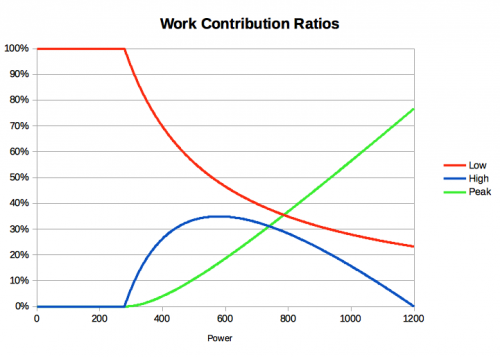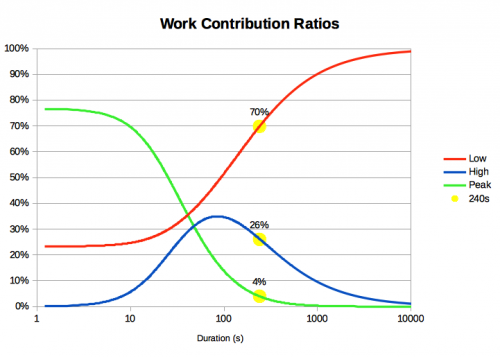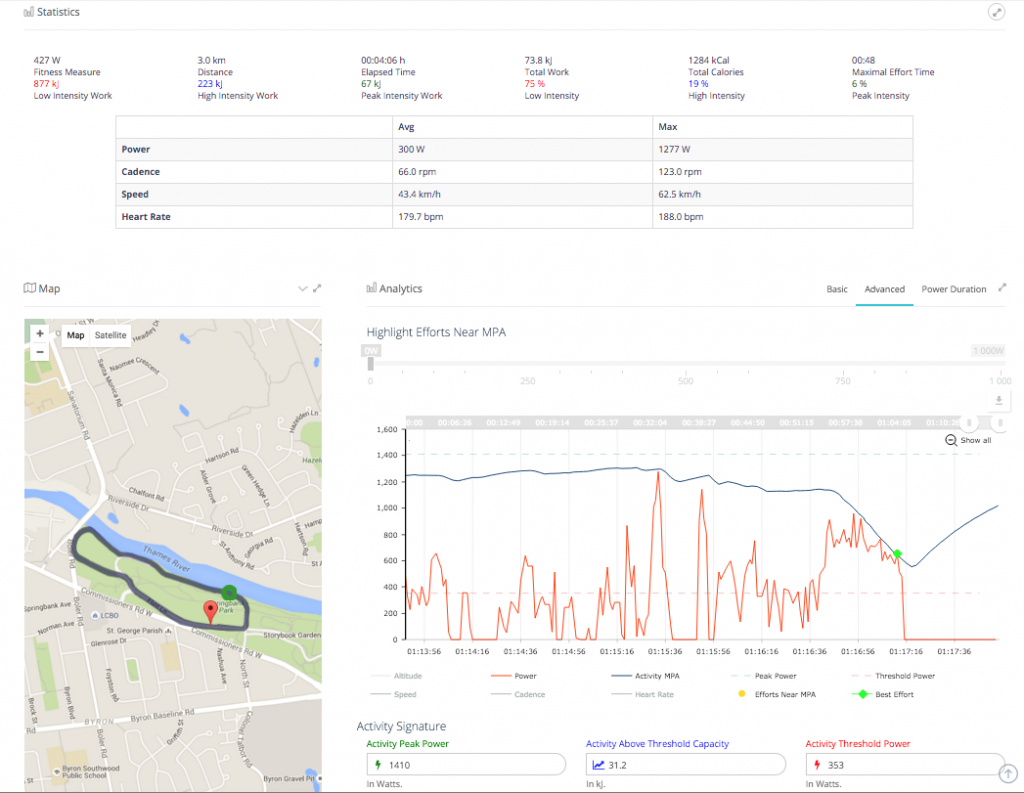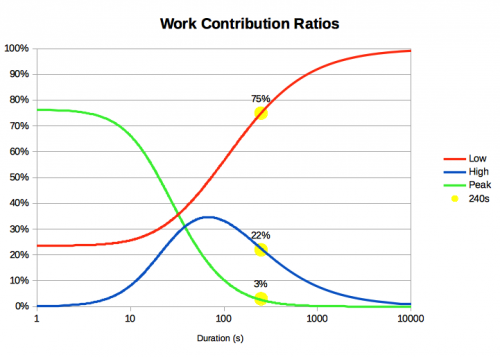Dissecting Power Data
With the knowledge of MPA and fitness signatures in hand, we can now start to examine how power is generated. That is, we can look to determine to what degree your individual fitness signature parameters impact your power.
When examining a power-duration relationship, an athlete’s peak power contributes a greater and greater proportion of the work performed as the power increases. Similarly, an athlete’s peak power has decreasing influence as power decreases:
Also, any power below threshold is neither influenced by your high intensity energy nor peak power, by definition of threshold power in the model. Only power values greater than threshold are influenced by the available capacity and by the athlete’s peak power.
Using our fitness model, driven by our three parameters, we can assign the relative influence of each fitness signature parameter to every power data point. We define these work aggregates in terms of intensities:
- Work attributable to Peak Power (PP) = Peak Intensity Work
- Work attributable to High Intensity Energy (HIE) = High Intensity Work
- Work attributable to Threshold Power (TP) = Low Intensity Work
Thus, for a given activity, we can determine how much work was performed by Threshold Power (Low Intensity Work), by High Intensity Energy (High Intensity Work) and Peak Power (Peak Intensity Work). The sum of these is the total work performed. Indeed, for a given proposed workout, we can predetermine how much work will be cumulate in each of the intensities. In devising a training program, these work allocation quantities can be tailored for the athlete in the context of the targeted event.
The Xert Progression Chart
In addition to cumulating work, we can also cumulate work at each intensity using an exponentially-weighted cumulative sum. This is called the Xert Progression Chart and a screenshot of the chart is shown below:
Each intensity has it’s own sum and we can see how the training we are doing adds up in terms of intensities.
Work Allocation Ratios and Training
When we examine the work allocation at a given power output, we see that there is a ratio for that power, based on an athlete’s fitness signature:
In the chart above, we see that for this athlete, at a duration of 240s (4 minutes), their relative contribution of work at each intensity is determined to be 70/26/4 for Low/High/Peak respectively. Ratios can be similarly determined at any duration. Using the specificity principle, one can conclude that to train at these ratios would be to train to improve performance at the 4 minute duration.
Ultra Short Race Pace Training
When we look at how Ultra-Short Race Pace Training (USRPT), a term used that describes a training method where workouts are performed by repeating the pace needed for competition, from the perspective of work performed, we would see that nearly all the work would be performed in the ratio needed for the race, i.e. the specificity principle is applied precisely. This is by definition, in fact. In our example above, all work would be accumulated in the ratio of 70/26/4, thus preserving the ratio needed for the race at all times.
For cycling, using our work allocation measurements, however, we can seek to achieve the same ratios, without having the repetition of the race pace as the only method to achieve this. By closely monitoring work allocation, we can perform a greater variety of training with the ultimate goal of achieving the same specificity needed for the event. For example, in order to prepare for longer events, but where shorter duration efforts will be the deciding factor in the race, an athlete may invest more time in longer workouts, accumulating low intensity training load but as the event nears, boost higher and peak intensity work in order to reach the same allocation ratios needed for the event. In many ways, the base-build-peak method, being the staple of many cyclists, fits the model of USRPT in an indirect way.
Looking at the event target duration and the work allocation ratios needed together with the Xert Progression Chart, athlete’s can prepare by performing workouts from Xert where the work allocation ratios match those of the event. This achieves a level of training specificity and preparedness like never before.
Using Work Allocation Ratios in Race and Training Plans – Reversing the Tables
Let’s say that an athlete would like to prepare for an event that they have done before. Using Xert, we can load an older race’s power data into the system and, using our fitness signature at the time, determine the work allocation and intensity work totals for the event:
Examining these ratios, Xert tells us that for this athlete, these work ratios equate to power at 4 minutes duration:
So, if the athlete is looking to prepare and train for the same race, they should be training and optimizing their performance at the 4 minute duration since that’s what the race demands. Workouts should accumulate training load according to the ratio governed by this duration. A workout is designed using the Xert Workout Designer to meet these exact ratios. We take the specificity principle and apply it all the way through the entire training plan.
In addition to the work allocation ratios, we can also examine the overall load. The race generated a load of about 1300kJ. In preparation for a race, the athlete should target to accumulate enough training load where this load would have been regularly performed by the athlete. By monitoring your progression, this can be measured and managed. The athlete can also aim to accumulate this load in the ratios needed for 4 minute power. This could be done with USRPT or using a more polarized method. The training program can be setup achieve the optimal load and work allocation.
Training Periodization
Training at the event’s target duration, especially when the durations are short, requires a lot of intensity. Maintaining a high level of intensity and volume over long periods may be difficult for some athletes and perhaps sub-optimal. It can also lead to overtraining syndrome.
Using our work-allocation-with-specificity training principles together with periodization concepts, athletes can train with specificity in such a way that they can periodize the intensity, from the beginning of the training program towards the target as the event date nears by varying the work allocation ratios.
As an example, an athlete may decide to start with endurance training, i.e. long duration training (to use our work allocation focus principles) and slowly increase their high and peak intensity work allocation by targeting shorter and shorter durations as their target event date nears. In the weeks before their event, they will move towards accumulating the appropriate training loads and in the specific ratios demanded by the event.
The same principle can also be performed in reverse, i.e. reverse periodization, where the initial target durations are short but extend to longer durations as the event nears. This can be effective if the work allocation ratio for the event is one that requires less high and peak intensity as it enables a greater low intensity work load to be accumulated.









